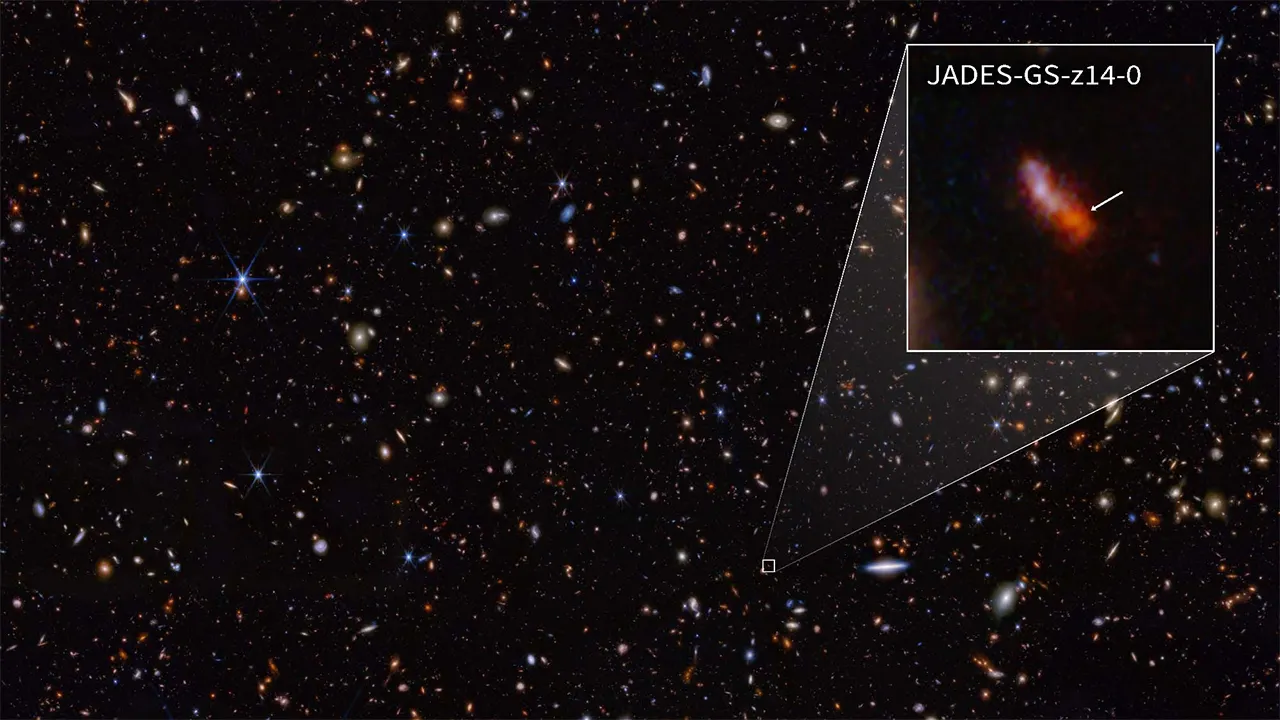The James Webb Space Telescope (JWST) has captured what scientists believe is the most distant known galaxy, after observing what astronomers call a “Cosmic Dawn” for the past two years.
NASA said in a press release that a “Cosmic Dawn” is the period in the first few hundred million years after the big bang, when the first galaxies were born.
The galaxies, NASA said, give scientists insight into how gas, stars and black holes changed when the universe was in its infancy.
A team of international astronomers used the Webb telescope in October 2023 and January 2024 to observe galaxies as part of the JWST Advanced Deep Extragalactic Survey (JAMES) program.
POWERFUL WEBB TELESCOPE SPIES SPECTACULAR STAR BIRTH CLUSTER BEYOND THE MILKY WAY

Scientists used NASA’s James Webb Space Telescope’s NIRSpec (Near-Infrared Spectrograph) to obtain a spectrum of the distant galaxy JADES-GS-z14-0 in order to accurately measure its redshift and therefore determine its age. The redshift can be determined from the location of a critical wavelength known as the Lyman-alpha break. This galaxy dates back to less than 300 million years after the big bang. (Credit: NASA, ESA, CSA, J. Olmsted (STScI). Science: S. Carniani (Scuola Normale Superiore), JADES Collaboration.)
During that period, the team collected the spectrum of what NASA referred to as a record-breaking galaxy, only 290 million years after the big bang.
The spectrum was measured by how much a galaxy’s light is stretched by the expansion of the universe, and in the case of the most distant galaxy known, it was measured with a redshift of about 14.
Two of the astronomers on the team, Stefano Carniani from Scuola Normale Superiore in Pisa, Italy, and Kevin Hainline from the University of Arizona in Tucson, Arizona, told NASA that in January 2024, Webb’s Near-Infrared Spectrograph (NIRSpec) observed the galaxy known to astronomers as JADES-GS-z14-0, for nearly 10 hours.
MERGER OF MASSIVE BLACK HOLES FROM EARLY UNIVERSE UNCOVERED BY WEBB TELESCOPE, SCIENTISTS SAY

The NIRCam data was used to determine which galaxies to study further with spectroscopic observations. One such galaxy, JADES-GS-z14-0 (shown in the pullout), was determined to be at a redshift of 14.32 (+0.08/-0.20), making it the current record-holder for the most distant known galaxy. This corresponds to a time less than 300 million years after the big bang. (Credit: NASA, ESA, CSA, J. Olmsted (STScI). Science: S. Carniani (Scuola Normale Superiore), JADES Collaboration.)
When the spectrum first processed, the astronomers said, there was unambiguous evidence the galaxy had a redshift of 14.32, which would shatter the most-distant galaxy record of 13.2, held by JADES-GS-z13-0.
The discovery of the spectrum was “incredibly exciting” for the entire team because of the mystery surrounding the source. They also said the most important aspect of the galaxy was how luminous the galaxy was from such a far distance.
The galaxy is estimated to be more than 1,600 light years across, and the light is suspected to be coming from young stars and not emission from a growing supermassive black hole.
WITNESS THE MESMERIZING CONJUNCTION OF THE MOON AND VENUS IN SPACE

The first anniversary image from NASA’s James Webb Space Telescope displays star birth like it’s never been seen before, full of detailed, impressionistic texture. The subject is the Rho Ophiuchi cloud complex, the closest star-forming region to Earth. It is a relatively small, quiet stellar nursery, but you’d never know it from Webb’s chaotic close-up. Jets bursting from young stars crisscross the image, impacting the surrounding interstellar gas and lighting up molecular hydrogen, shown in red. Some stars display the telltale shadow of a circumstellar disk, the makings of future planetary systems. (Credits: NASA, ESA, CSA, STScI, Klaus Pontoppidan (STScI))
The starlight also implies the galaxy is several hundreds of millions of times the mass of the Sun, the astronomers claim, leading to more mysteries of how it can make such a bright and massive galaxy in less than 300 million years.
The astronomers learned through the data that the color of the galaxy was reddened by dust and was not as blue as it could be in early phases of the galaxy.
Wavelengths of light collected by Webb’s Mid-Infrared Instrument (MIRI) indicated the brightness of the source was above what would be extrapolated from the measurements of other instruments on the telescope, suggesting the presence of ionized gas emission from hydrogen and oxygen.
They say oxygen being present at such an early stage suggests multiple generations of massive stars already lived their lives before the telescope was able to observe the galaxy, the astronomers said.
“All of these observations, together, tell us that JADES-GS-z14-0 is not like the types of galaxies that have been predicted by theoretical models and computer simulations to exist in the very early universe,” the astronomers said in the press release. “Given the observed brightness of the source, we can forecast how it might grow over cosmic time, and so far, we have not found any suitable analogs from the hundreds of other galaxies we’ve observed at high redshift in our survey.
“It is likely that astronomers will find many such luminous galaxies, possibly at even earlier times, over the next decade with Webb,” the team added. “We’re thrilled to see the extraordinary diversity of galaxies that existed at Cosmic Dawn!”
CLICK HERE TO GET THE FOX NEWS APP
The findings are still being studied and have not been through the peer-review process, according to NASA.
The Webb Telescope, the successor to the Hubble and the largest telescope ever launched into space, is a joint project of NASA and the European Space Agency.






